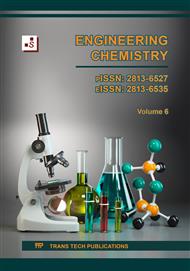[1]
F. O. Kolawole et al., "Mitigation of Corrosion Problems in API 5L Steel Pipeline – A Review," J. Mater. Environ. Sci., vol. 9, no. 8, pp.2397-2410, 2018.
Google Scholar
[2]
L.T. Popoola, A.S. Grema, G.K. Latinwo, B. Gutti, A.S. Balogun, "Intern. J. Indus. Chem.," vol. 35, no. 4, p.1, 2013.
Google Scholar
[3]
J. Anthony von Fraunhofer, "Adhesion and Cohesion," Int. J. Dent., vol. 2012, Article ID 951324, 8 pages, 2012.
Google Scholar
[4]
Johanna Rajasarkk et al., "Drinking Water Contaminants from Epoxy Resin-Coated Pipes: A Field Study," vol. 103, pp.133-140, 2016.
DOI: 10.1016/j.watres.2016.07.027
Google Scholar
[5]
A. Jones, B. Smith, "Advancements in Epoxy Coatings for Corrosion Protection: A Comprehensive Review," J. Mater. Sci. Technol., vol. 25, no. 3, pp.315-330, 2009.
Google Scholar
[6]
R. Kumar, S. Gupta, "Recent Trends in Epoxy Resin Formulations and Applications," Prog. Polym. Sci., vol. 37, no. 3, pp.340-368, 2012.
Google Scholar
[7]
M. Rahman, S. Khan, "Food-Grade Epoxy Coatings: Challenges and Developments," J. Coat. Technol. Res., vol. 14, no. 5, pp.1075-1091, 2017.
Google Scholar
[8]
J. Li, C. Wang, "Carcinogenic Substances in Epoxy Resins and Alternatives for Food-Grade Applications," Mater. Today, Chem., vol. 13, pp.17-26, 2019.
Google Scholar
[9]
N. Patel, P. Sharma, "Innovative Approaches in Epoxy Coating Technology for Corrosion Mitigation," Surf. Coat. Technol., vol. 280, pp.125-134, 2015
DOI: 10.1016/j.surfcoat.2015.08.019
Google Scholar
[10]
Mohammad Khani et al., "Designing a dual-functional epoxy composite system with self-healing/barrier anti-corrosion performance using graphene oxide nano-scale platforms decorated with zinc-doped conductive polypyrrole nanoparticles with great environmental stability and non-toxicity," Chemical Engineering Journal, vol. 382, 2020, 122819
DOI: 10.1016/j.cej.2019.122819
Google Scholar
[11]
Trinh Anh Truc, et al., "8-hydroxyquinoline-modified clay incorporated in an epoxy coating for the corrosion protection of carbon steel," Surfaces and Interfaces, vol. 14, pp.26-33, 2019
DOI: 10.1016/j.surfin.2018.10.007
Google Scholar
[12]
Feng-Qi Liao, Yung-Chung Chen, "Siloxane-based epoxy coatings through cationic photopolymerization for corrosion protection," Progress in Organic Coatings, vol. 174, 107235, 2023
DOI: 10.1016/j.porgcoat.2022.107235
Google Scholar
[13]
S. Mohammadkhah, et al., "Improvement of active/passive anti-corrosion/weathering properties of epoxy-siloxane structure via cloisite 30B/polyaniline inclusion as a new hybrid nanocomposite coating," Colloids and Surfaces A: Physicochemical and Engineering Aspects, vol. 666, 2023
DOI: 10.1016/j.colsurfa.2023.131297
Google Scholar
[14]
Min Sun, Zhidong Ma, Anhang Li, Guiyu Zhu, Yue Zhang, "Anticorrosive performance of polyaniline/waterborne epoxy/poly(methylhydrosiloxane) composite coatings," Progress in Organic Coatings, vol. 139, 105462, 2020
DOI: 10.1016/j.porgcoat.2019.105462
Google Scholar
[15]
Y. Guo et al., "Preparation and performance of a composite epoxy coating based on modified hydroxyapatite," Surf. Coat. Technol., vol. 443, 128614, 2022. DOI:10.1016/j.surfcoat.2022. 128614
DOI: 10.1016/j.surfcoat.2022.128614
Google Scholar
[16]
Y. Morozov et al., "Epoxy coatings modified with a new cerium phosphate inhibitor for smart corrosion protection of steel," Corros. Sci., vol. 159, 108128, 2019
DOI: 10.1016/j.corsci.2019.108128
Google Scholar
[17]
A.M. Atta et al., "Self-healing of chemically bonded hybrid silica/epoxy for steel coating," Prog. Org. Coat., vol. 141, 105549, 2020
DOI: 10.1016/j.porgcoat.2020.105549
Google Scholar
[18]
F. Presuel-Moreno, M.A. Jakab, N. Tailleart, M. Goldman, J.R. Scully, "Corrosion-resistant metallic coatings," Materials Today, vol. 11, no. 10, pp.14-23, 2008
DOI: 10.1016/S1369-7021(08)70203-7
Google Scholar
[19]
Wufang Yang, Weibin Feng, et al., "Protection of mild steel with molecular engineered epoxy nanocomposite coatings containing corrosion inhibitor functionalized nanoparticles," Surface and Coatings Technology, vol. 406, 126639, 2021
DOI: 10.1016/j.surfcoat.2020.126639
Google Scholar
[20]
Zhenhua Zhang et al., "Self-healing nanocomposite coatings containing organic-inorganic inhibitors functionalized dendritic silica nanocontainers for synergistic corrosion protection of carbon steel," Colloids and Surfaces A: Physicochemical and Engineering Aspects, vol. 656, Part A, 130430, 2023. ISSN 0927-7757
DOI: 10.1016/j.colsurfa.2022.130430
Google Scholar


